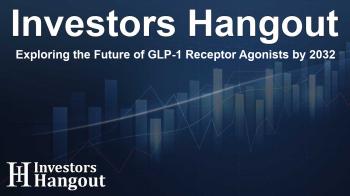Exploring the Future of GLP-1 Receptor Agonists by 2032

The Rapid Growth of the GLP-1 Receptor Agonist Market
The market for GLP-1 receptor agonists is on a significant upward trajectory, expected to soar from its valuation of USD 43.79 billion in 2023 to an astounding USD 193.56 billion by 2032. This remarkable growth, at a compound annual growth rate (CAGR) of 17.61%, showcases the increasing demand for innovative treatments tailored for managing type 2 diabetes and obesity.
Understanding GLP-1 Receptor Agonists
GLP-1 (glucagon-like peptide-1) receptor agonists represent a fascinating development in therapeutic interventions. These drugs not only enhance glycemic control but also assist in significant weight loss, addresses cardiovascular risks, and effectively tackle the global health crises of diabetes and obesity. With growing awareness around these treatments, their adoption is rapidly increasing in both developed and developing markets.
The Surge in Demand for GLP-1 Therapies
The demand for GLP-1 therapies continues to rise due to a combination of factors, including increased public awareness of metabolic disorders and successful clinical outcomes. Market leaders such as Novo Nordisk and Eli Lilly are pioneers in this space, offering breakthrough therapies that are changing traditional treatment paradigms and positively influencing healthcare outcomes.
Key Players in the GLP-1 Landscape
Market players have made remarkable strides in this domain, with companies like Novo Nordisk (Ozempic, Wegovy), Eli Lilly (Trulicity, Zepbound), and Sanofi (Adlyxin, Soliqua) at the forefront. Other notable contributors include AstraZeneca, Pfizer, Amgen, and several emerging biotechnology firms that are actively developing novel formulations and delivery methods for diabetes care.
Key Market Insights
The GLP-1 receptor agonist market is segmented based on product, application, and route of administration. The product segment is dominated by Ozempic, a medication known for its effectiveness in controlling blood sugar levels and aiding weight loss among patients with type 2 diabetes. It currently holds a substantial market share and is preferred for its weekly dosage, which enhances patient adherence.
Market Segmentation Analysis
In terms of application, the type 2 diabetes mellitus segment holds a staggering 59% market share due to the rising prevalence of diabetes worldwide. Doctors increasingly recommend GLP-1 receptor agonists as either primary or supplementary treatments due to their dual benefits of reducing blood glucose levels and promoting weight loss.
Administration Routes and Their Impact
Parenteral administration remains the leading method in administering GLP-1 receptor agonists. The availability and efficacy of injectable formulations provide rapid results in blood sugar management, which is crucial for individuals managing diabetes effectively.
Regional Market Dynamics
North America currently leads the GLP-1 receptor agonist market, capturing approximately 75.14% of the share. This success can be attributed to advanced healthcare infrastructure, early adoption of innovative diabetes therapies, and the presence of major pharmaceutical companies in the region.
Regions like Asia-Pacific are projected to register the fastest growth due to increasing awareness and expanding access to healthcare options. The mounting incidence of diabetes and obesity in countries such as India and China drives demand for GLP-1 therapies, bolstered by government initiatives and improving healthcare systems.
Frequently Asked Questions
What are GLP-1 receptor agonists?
GLP-1 receptor agonists are medications that mimic the actions of glucagon-like peptide-1 to enhance glycemic control and promote weight loss in patients with type 2 diabetes.
Which companies are leading the GLP-1 market?
Notable companies in the GLP-1 receptor agonist market include Novo Nordisk, Eli Lilly, and Sanofi, among others, leading the development of innovative treatments.
What is driving the growth of this market?
The growth is driven by increasing awareness of diabetes and obesity, alongside favorable clinical outcomes and emerging treatment options that expand their usage in various clinical settings.
What are the projected market figures by 2032?
By 2032, the GLP-1 receptor agonist market is anticipated to reach USD 193.56 billion, highlighting its importance in diabetes management.
How do GLP-1 receptor agonists help patients with type 2 diabetes?
GLP-1 receptor agonists manage blood glucose levels, promote weight loss, and reduce cardiovascular risks, making them advantageous for patients with type 2 diabetes.
About The Author
Contact Caleb Price privately here. Or send an email with ATTN: Caleb Price as the subject to contact@investorshangout.com.
About Investors Hangout
Investors Hangout is a leading online stock forum for financial discussion and learning, offering a wide range of free tools and resources. It draws in traders of all levels, who exchange market knowledge, investigate trading tactics, and keep an eye on industry developments in real time. Featuring financial articles, stock message boards, quotes, charts, company profiles, and live news updates. Through cooperative learning and a wealth of informational resources, it helps users from novices creating their first portfolios to experts honing their techniques. Join Investors Hangout today: https://investorshangout.com/
The content of this article is based on factual, publicly available information and does not represent legal, financial, or investment advice. Investors Hangout does not offer financial advice, and the author is not a licensed financial advisor. Consult a qualified advisor before making any financial or investment decisions based on this article. This article should not be considered advice to purchase, sell, or hold any securities or other investments. If any of the material provided here is inaccurate, please contact us for corrections.

